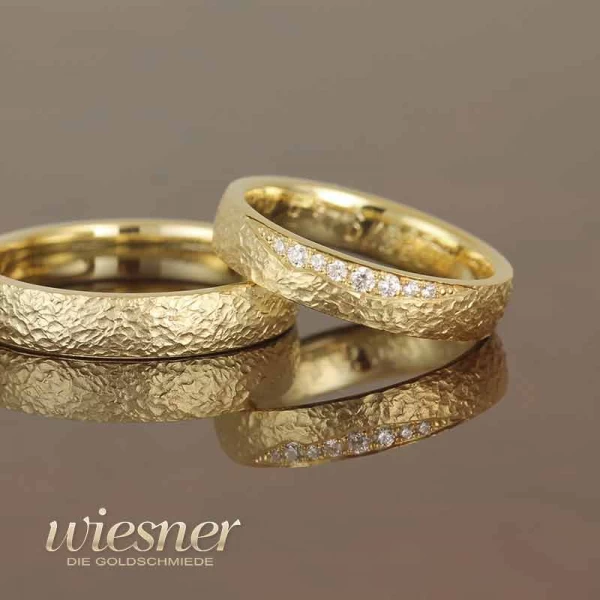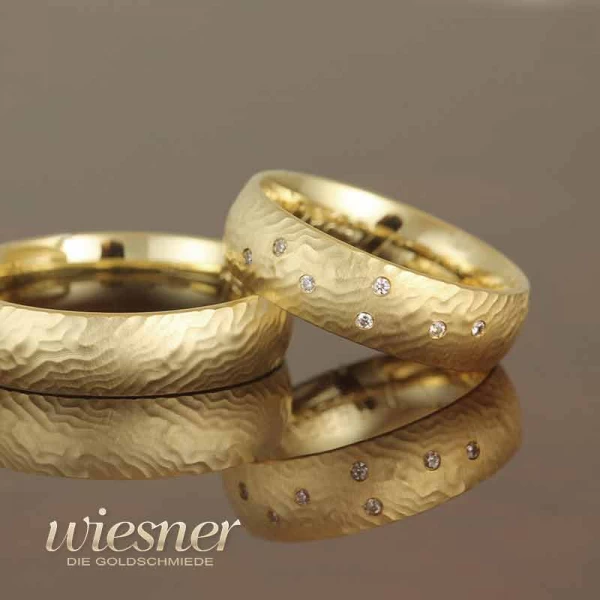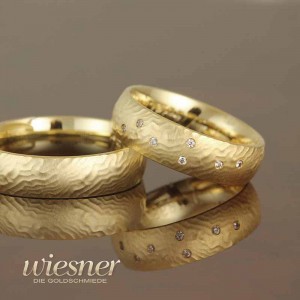


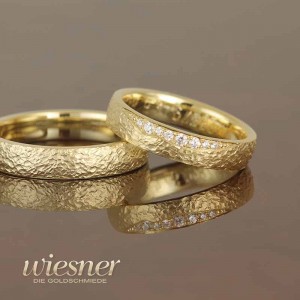




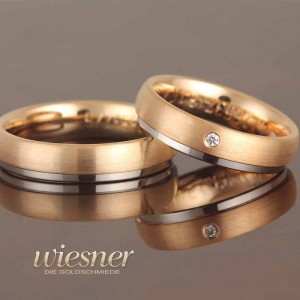
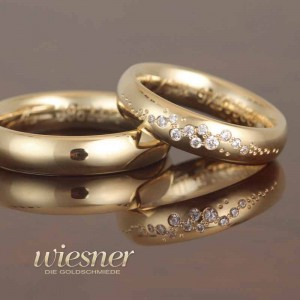


Eheringe in Gold - Ihre perfekte Wahl für zeitlose Liebe
Mokume Gane seamlessly forged - A special quality feature
Master Goldsmith Markus Wiesner forges your Mokume Gane wedding rings exclusively with the symbolic power of endlessness. This has long been standard for classic wedding rings. The basis for this is the very elaborate forging technique of splicing and spiking the Mokume Gane material. This is the only way to create rings and wedding rings whose pattern can be seen around the ring without any interruption or solder joint. We call this method also the seamless technique.
Besides the beautiful symbolism this technique offers further advantages. Band rings, as the rings soldered with butt joint are called in the technical language, show the already mentioned unsightly pattern interruption of the Mokume Gane. In addition, small pores often appear in the solder joint, or the colour of the solder clearly stands out from the actual colours of the Mokume Gane wedding rings.
Furthermore, this solder joint is very likely to break open if the width of the rings changes later. A repair is still possible by an experienced Mokume Gane blacksmith, but not without a significant change of the Mokume Gane pattern. In the following we show you two pictures of so-called band rings (with solder joint) of a foreign manufacturer, which we received for revision.
video: Wiesner Mokume Gane wedding rings in seamless technique
Mokume Gane wedding rings quality
- left: Mokume Gane wedding rings in seamless technique (all around without joint)
- right: Mokume Gane rings manufactured as band rings. Well visible solder joint.
Advantages versus disadvantages:
- Seamless: no pattern interruption, endless symbolism, easy width change - Slightly more costly to make.
- With joint: pattern interruption, solder often visible, solder often shows stronger tarnishing, width change can cause problems, unsightly appearance - Significantly less work required.

With Mokume Gane rings there are differences in quality and price
Are there Mokume Gane imitations?
If you take a closer look at the internet and some shops offering Mokume Gane you will notice that there are many different versions and qualities of this technique. The Japanese name Mokume Gane means nothing else but "wood-structured metal", and says nothing about the exact manufacturing method and quality of the ring or wedding ring.
As we are constantly encountering this uncertainty in our daily work in advising our customers, we would now like to provide all interested parties with a clarifying overview of the characteristics of this technique known to us so far. We have given a name to the previously known designs in order to distinguish them clearly from each other.
- GravoMokume
- MokumeCover
- MokumeSeam
- MokumeSeamless
We at "Wiesner - Die Goldschmiede" do not want to presume to declare something right or wrong. Everything has its justification when it is offered as what it is. However, it is important to us to call the different qualities by their names in order to solve any confusion among our esteemed interested parties.
Mokume Gane wedding rings from our workshop in seamless technique:
Gravo Mokume (Pattern engraved):

The Gravo Mokume is a ring or wedding ring made of stainless steel, as well as precious metals such as yellow gold, white gold, red gold, etc., to which the pattern of a Mokume Gane wedding ring has been superficially added by means of engraving. The pattern of a Mokume Gane wedding ring has been added to the surface of the ring by means of engraving. Basically, this can be easily recognised by the fact that no pattern can be seen on the inside of the rings, or that the pattern itself does not show any two colours. If necessary, it is possible that an apparent two-colour effect has been produced by blackening the engraving with a laser or suitable chemicals.
If the engraving is sufficiently deep, it might also be possible to cover the engraving with a second colour. For example, by incorporating yellow gold into the engraved pattern of a white gold ring. The production of a wedding ring in GravoMokume is relatively simple and quick. For example, with an engraving laser.
Mokume Cover (Mokume covered):

MokumeCover is a thin, usually 0.5 - 0.8 mm thick Mokume Gane sheet, which is wrapped around an existing stainless steel or precious metal wedding ring and soldered to it. It should be noted that the Mokume Gane sheet used is usually actually welded and patterned precious metal. Here, too, yellow gold, white gold, red gold, green gold, platinum or palladium, as well as silver may have been used. The combination of copper and silver is also frequently found in MokumeCover.
MokumeCover, like GravoMokume, can first be recognised by the fact that the typical pattern on the inside and edges of the wedding rings is not to be found. Another distinguishing feature is the usually existing pattern interruption, which can be clearly recognised as a transverse line on the outside of the rings. In very rare cases, an endless pattern can also be found.
Compared to GravoMokume, MokumeCover wedding rings are somewhat more complex to produce. Changing the ring width, especially widening a wedding ring, is hardly possible with MokumeCover.
Mokume Seam (soldered band ring):

MokumeSeam wedding rings are also called band rings because of the way they are made in the goldsmith's trade. Here, a mokume gane strand is made from various precious metals, or possibly also non-precious metals, and rolled into a sufficiently long band.
The goldsmith then forges this band into a round ring until the two ends of the band touch. The wedding ring is then soldered there.
This is a tried and tested technique of the goldsmith's craft for making rings or wedding rings. In this respect, this technique is of course also used in the production of many a Mokume Gane wedding ring.
From time to time we could also find MokumeSeam wedding rings on the web, which were very cleverly soldered together diagonally in a diagonal pattern. Here, even the expert has to look closely to recognise the time-saving trick. MokumeSeam wedding rings can cause serious problems when the ring width is changed and break open at the solder joint.
Mokume Gane wedding rings in seamless technique (traditional technique, endless forged without hem)
This is the traditional forging technique of mokume gane wedding rings, as produced by any goldsmith who accepts and masters the challenge of splicing mokume gane material.
Basically, this is the only type of manufacturing that does justice to the symbolism of a wedding ring, namely endlessness. These traditionally made mokume gane wedding rings can be recognised by the pattern that is visible on the inside and outside and runs around the ring without interruption. In addition to the advantage of not having any unsightly pattern interruptions, the ring width of endlessly crafted Mokume Gane wedding rings can be changed without any problems.
"Wiesner - Die Goldschmiede" exclusively offers mokume gane in seamless technique (traditional technique, endless pattern).
Some insights into our Mokume Gane wedding ring workshop
Production of Mokume Gane wedding rings in our workshop
Mokume Gane Wedding Rings | The Bar:
Master goldsmith: Markus Wiesner | Music: Michael Wiesner
Glow, roll, glow, roll | This is how Mokume Gane wedding rings are made
Mokume Gane wedding rings | The pattern is brought in
And forge and roll again.
Marking and drilling the Mokume Gane rings
What are Mokume Gane rings?
A special centuries-old Japanese forging technique
The Mokume Gane technique originated in Japan about 350 years ago. Mokume Gane wedding rings, which are made with this old Japanese forging art, are very special unique pieces. Mokume Gane wedding rings are created by welding together thin layers of precious metal, which are then forged and patterned. In this way, new and unique patterns and colour gradients are created again and again - depending on the precious metals and patterning techniques used. A pair of Mokume Gane rings is always made from one piece of welded base material. This way, both Mokume Gane wedding rings will look very similar to each other.
Hand-forged in countless different designs
Just as individual as the patterns of the Mokume Gane rings are, so individual can your wedding ring be made for you. The ladies' ring, for example, can be embellished with a single diamond as well as with many small stones.
Mokume Gane wedding rings made of precious metals
Whether gold, silver, platinum or palladium - we forge Mokume Gane rings for you in a wide variety of materials. We will be happy to make a very individual pair for you.
Wearing comfort of Mokume Gane partner rings
Of course, besides the appearance, the wearing comfort of partnership rings, i.e. also of Mokume Gane wedding rings, plays a major role. After all, the wedding ring accompanies you day after day. For this reason, the height, width and profile of the ring are adapted to your personal preferences.
Do you have any questions about Mokume Gane wedding rings?
We are always there for you. Whether in person in our shop or by phone - we will be happy to help you choose the perfect Mokume Gane wedding rings and advise you in detail. Let us inspire you and find the right wedding rings for your big day and for life in our studio. Is it also possible to make a single ring or engagement ring? In addition to the Wiesner Mokume Gane ring collection, we also make a jewellery collection and engagement ring for you using the Mokume Gane technique. We also produce customised jewellery rings.
Historical development of the Mokume Gane
Mokume Gane | jap.: wood-patterned metal | Historical development
The Damascus Steel Fallacy
With the search for an improved material for the blades of weapons, the era of patterned metals also began. It was in Damascus that Europeans first found sabre weapons of exceptionally high quality steel. For this reason, the material is also mistakenly called Damascus steel by the crusaders. This weapon steel surprises above all by its hitherto unknown springiness and strength.
Patterned steel
Furthermore, its wave-like and mottled patterns are fascinating. The 6th century Roman scholar Cassiodorus describes these weapons as "...forged by Vulcan..." and " ...not the work of a mortal, but the work of a god." Looking at the development of this new steel, it seems to have taken place independently in quite different areas of Europe as well as Asia.
From Rome to Malaysia
Layered blades appear in Old Norse sagas as well as in archaeological excavations at sites dating back to the 2nd century and of Roman origin. The 13th century Malay dagger "Kris" is made of fire-welded steel. Several alternating layers of soft iron and steel form the dagger blade after multiple folding and forging as well as etching of the surface.
Damascus steel in China and Japan
Layered steel appeared in China as early as the 1st century BC. The Japanese samurai, or rather their weaponsmiths, then developed layered steel to perfection. Here, the steel is enriched with carbon during the welding process.
First Mokume Gane by Denbei Shoami
The bladesmith Shoami (1651-1728) from Akita in Japan made a name for himself with extraordinary works in steel as well as in softer materials alloyed with precious metals. For the first time he welded non-ferrous metals and decorated them artistically. He called it mokume gane (wood-textured metal). The Kizuka sword hilt, worked in mokume gane, is considered his first work. He used silver, gold and shakudo for it. Many old samurai swords have round or oval discs worked in mokume gane as blade ends and hand guards.
Why Mokume Gane is so pronounced in Japan?
There are several reasons why the technique of mokume gane became so well established in Japan. Two of them are certainly the highly developed art of sword making and the extensive knowledge in the field of metallurgy. The existence of large schools and an excellent exchange of information also favoured the far-reaching development of the mokume gane. In addition, there were unique coloured metal alloys in Japan, such as, Shakudo | Shibuishi | Kuromido.
Precious metal was scarce
These predominantly copper alloys were created mainly due to the lack of precious metals such as gold and silver, which were very rare in Japan and therefore highly priced. There are no other known historical mokume gane works outside Japan.
Well-kept secrets
Why was the Mokume Gane technique not known outside Japan for a long time? For one thing, Japan was an isolated island until 1853. The techniques of Japanese artists and craftsmen were well guarded as secrets. In addition, mokume gane was an ancient tradition within the art of swordsmithing and was therefore reserved for that purpose.
Industrial Revolution in Europe suppresses Mokume Gane
Secondly, the industrial revolution developed in western countries, which meant that crafts and emotions that seemed alchemical were increasingly frowned upon. Instead, everything that could be produced quickly and cheaply in large quantities developed here.
The turning point for the Mokume Gane
It was not until the sixties that jewellery began to change from being a purely decorative, prestigious financial investment to being viewed more and more from an artistic point of view. This was the basis for the discovery and further development of mokume gane in the USA in the seventies.
There, it was Hiroko Sato and Gene Pijanowski who began to work with the mokume gane in the seventies. After some unsatisfactory results, the two went to Japan to learn the classical Mokume Gane technique. Back home, they developed the Mokume Gane techniques further and produced, among other things, large vessels as well as pieces of jewellery.
-
1970: Soldered metal layers by George Sayer, USA
-
1978: Mc Cullum from England travelled to Japan to learn the Mokume Gane techniques and worked on great vessels back in England.
-
1980: Steven D. Kretschmer, USA, learned the Mokume Gane technique from Sato and Pijanoeski and from then on worked on gold Mokume Gane bars without the use of solder.
Since mokume gane requires a considerable amount of time and material, it was initially unable to spread for a long time due to both labour time and cost reasons.
Mokume Gane wedding rings - costs and production time
What do Mokume Gane wedding rings cost?
In our shop you will find some examples of wedding ring pairs with the corresponding prices. However, as Mokume Gane jewellery is unique and is designed individually in dialogue with you, we do not usually work with all-inclusive prices. Of course, we will be happy to prepare an individual offer for you. For this reason, we would like to invite you to a consultation in our studio, or, if you are enquiring from a greater distance, we can also offer you a non-binding preliminary telephone consultation. Simply send us a short email with your telephone number. We will be happy to call you back. You can also contact Mr. Michael Wiesner directly at +49 (0) 7062 22991 for a consultation. To give a small indication regarding the prices of Mokume Gane rings: For well-crafted, endless wedding rings you can calculate from about 2.000,-- Euro.
How much time do you have to plan for the production?
For the production of your Mokume Gane wedding rings we generally estimate a period of 4 - 8 weeks. However, in individual cases we can bring your order forward. In this case, your rings can be finished within one week. Please contact us in any case. Just send us a short email with your telephone number. We will be happy to call you back. You can also contact Mr. Michael Wiesner directly at +49 (0) 7062 22991 for a consultation or use the contact form at the bottom of the website.
Mokume Gane wedding rings - ring profiles, width and thickness
The ring thickness or profile height of Mokume Gane wedding rings is freely selectable.
The ring thickness, or profile height, of Wiesner Mokume Gane wedding rings can be individually adjusted. We usually use a measurement of 2.0 mm. However, this can be increased or decreased according to your individual wishes. Depending on the height of the stone, it is sometimes necessary to increase the height of the ring profile when using diamonds. Ultimately, however, your personal feeling when wearing the ring should be decisive for the profile height. If the profile is too high, it can sometimes be annoying on the neighbouring fingers or cause pain when shaking hands.
Ring profiles for Mokume Gane rings.
Since Mokume Gane jewellery and wedding rings are completely custom-made, almost all conceivable ring profiles are possible here. Here are some examples:
- flat on the outside
- slightly domed on the outside
- outside medium curved
- strongly curved on the outside
The curvature of a ring profile is often referred to in technical jargon as cambered or taut. The insides of our rings are usually slightly domed. This significantly increases the wearing comfort. Especially on days when your fingers are slightly swollen, the ring still glides over your finger joint. With wide rings, from approx. 6 mm and wider, there is also better ventilation of the skin under the ring.
The width of Mokume Gane wedding rings
The ring width of Mokume Gane wedding rings can be individually adjusted to your wishes. It is advisable not to go below a width of 4 mm. Mokume Gane wedding rings live from the beautiful patterns. The narrower the ring, the less of the pattern is visible. There are only upper limits to the width of the ring that can be worn. Here we consider a ring width of 14 mm to be the measure at which wearing comfort is still given. But in the end this is a subjective feeling and can vary in individual cases.
Allergies with Mokume Gane wedding rings
Mokume Gane wedding rings are often made of silver.
During consultations, we are often asked why many Wiesner Mokume Gane wedding rings contain layers of silver, and whether these can be replaced by white gold. In principle, of course, white gold can also be used. We use silver when the rings are to be given a 3-dimensional structure on the surface by etching. In this case, the silver is slightly reduced in height. This is only possible to a limited extent with white gold and often leads to unattractive results. Furthermore, the silver with its light colour forms a beautiful contrast to other precious metals such as palladium, yellow gold or red gold. White gold and palladium, on the other hand, hardly form a respectable colour contrast.
Are there any known allergies to Mokume Gane wedding rings?
Wiesner Mokume Gane wedding rings are made exclusively from nickel-free precious metal alloys. Nickel allergies, which have become widespread in the meantime, are therefore ruled out.
Diamonds in Mokume Gane wedding rings
Können in Mokume Gane Trauringe Diamanten eingearbeitet werden?
Can diamonds be incorporated into Mokume Gane wedding rings?
Of course, it is also possible to include one or more brilliant-cut diamonds in Wiesner Mokume Gane wedding rings (brilliant = brilliant-cut diamond). We usually work with the diamond quality fine white, small inclusions (TWSI). However, any other quality can be used on request. Brilliants can generally be rubbed into the surface of the ring, i.e. set flat and flush with the surface.
However, it is also possible to set a larger brilliant-cut diamond (from approx. 0.10 carat) as a stretched stone in a ring band that is open at the top. In addition to brilliant cut diamonds, we also process princess cut diamonds, navette cut diamonds, heart cut diamonds and many other types of cuts.
Ring changes for Mokume Gane wedding rings
Is it possible to change the ring of a Mokume Gane wedding ring?
Many people think that Mokume Gane rings cannot be adjusted in width. This is not correct. Wiesner Mokume Gane wedding rings can be widened or narrowed by any experienced Mokume Gane goldsmith. For this purpose, a procedure is used which is already applied during the production of your wedding rings. Of course, the surface has to be reworked afterwards, as is the case with many classic wedding rings.
Never take your Mokume Gane wedding rings to a goldsmith or jeweller who is not familiar with Mokume Gane. There is a risk that they will try to stretch the rings or saw them open to remove or insert parts. If the rings are stretched, they may crack. If they are sawn open, the beautiful pattern will be partially lost, or the rings will lose their symbolic character of endlessness.
Mokume Gane wedding rings are made by us in a traditional way by slitting and splicing in order to preserve this symbolic character. For more detailed questions, simply send us a short email with your telephone number. We will be happy to call you back. You can also contact Mr. Michael Wiesner directly at +49 (0) 7062 22991 for a consultation.
Everyday suitability of Mokume Gane wedding rings
Mokume Gane wedding rings are suitable for everyday use
Mokume Gane wedding rings are in no way inferior to conventional wedding rings in terms of the durability of metal colours and surface structures. Traces of wear are completely normal with both conventional wedding rings and Mokume Gane wedding rings and occur to a greater or lesser extent depending on the wearing habits. Incidentally, you may return your Wiesner Mokume Gane wedding rings to our goldsmith's studio once a year free of charge (except for postage) for reconditioning.
Tarnishing of Mokume Gane wedding rings
Colour changes due to the well-known tarnishing of precious metals only occur in very rare cases. The cases known to us so far were caused by water additives in swimming pools, such as chlorine or silver ions (the latter is often used in pools in the USA). In such cases, it is advisable to remove the wedding rings before going into the swimming pool.
Mokume Gane wedding rings and surface abrasion
The popular structure of Wiesner Mokume Gane wedding rings can change minimally over the years and decades due to abrasion (1/100 millimetre range). The long duration of this process, however, hardly allows a conscious perception. Since the wood-like structure of Wiesner Mokume Gane wedding rings moves through the entire ring cross-section, it is impossible for the pattern to disappear.
Mokume Gane and wedding rings
Mokume Gane is a centuries-old forging technique from Japan.
It developed from the art of sword forging. The far better known technique of Damascus steel forging, which in our culture takes its name from the first place where it was found, Damascus in Syria, produced the welding and structuring of the Mokume Gane.
Decorative elements on the hilt and the end of the hilt, as well as the scabbard, were first made by Denbai Shoami from softer alloys with a high copper content. As the precious metal gold was very rare in Japan and therefore very expensive, the gold content of the Mokume Gane alloys of the time was limited to about 4%. The remaining parts were primarily copper and silver.
Even today, the Mokume Gane goldsmith often works with alloys such as Shibuichi, or Shakudo. After sampling the layered and welded sheets, wonderful colours can be created with these alloys by producing a patina using various stains.
However, as these are purely superficial, they can rub off very easily when worn on, for example, wedding rings. For this reason, all these beautiful colours are not applicable in the production of mokume gane wedding rings. Here, the time-honoured precious metals such as gold, silver, platinum and palladium have proven their worth. Of course, white gold alloys can also be used, but this is rarely used due to the lower contrast to the other metals and the higher price compared to palladium.
We always weld the mokume gane base material for the wedding rings from our workshop ourselves in a temperature-controlled welding process in the kiln. Depending on the composition of the material, the layers of precious metal remain in the kiln for between 10 and 15 hours. Without any solder or other bonding agents, a so-called sintering process takes place in which the atoms begin to mix at the boundaries to the respective neighbouring sheet. This happens in the 1/1000 millimetre range. Every small impurity or fingerprint between the sheets disturbs this sintering process and renders the Mokume Gane ingot unusable. This can then only be broken down again chemically in a refinery.
Once the welding is successful and the ingot has cooled down again, the actual production of the Mokume Gane wedding rings begins. First the Mokume Gane ingot is forged and rolled to the right length and cross-section. At regular intervals the material has to be relaxed by annealing. During this so-called recrystallisation annealing, the partially broken atomic structures are realigned. The precious metal regains its pliable properties and can be further shaped. Once annealed too late, the material also visibly cracks or welds loosen, making the mokume gane ingot unusable.
Once the material is the right length, the splicing process begins. For this, slits are sawn into the strand, which are then expanded into round rings using small chisels and later a steel mandrel. This is the only method by which Mokume Gane wedding rings can be made without pattern interruption and unsightly seams. Not all mokume makers use this seamless technique, as it is very time-consuming and requires a lot of practice.
But the result is all the more beautiful. The symbolic power of endlessness.
More Mokume Gane jewellery and collections: :
Mokume Silver Collection
A Mokume Gane jewellery collection by Michael Wiesner
The collection "Mokume Silver" was designed by Michael Wiesner, one of the two owners of "Wiesner - Die Goldschmiede". The aim was to offer a small but fine line of Mokume Gane jewellery, which combines both the uniqueness of this wonderful craft and the cost advantages of small series production. The aim was to create unique pieces that are priced well below the usual one-off production of Mokume Gane, in order to open up this wonderful forging technique and its visual charms to a wider circle of enthusiasts.
Mokume Gane jewellery and CAD design
For the reasons mentioned above, Michael Wiesner designed the four basic models Funa, Kora, Gongu and Kokoro by means of CAD construction and thus already prepared the basic bodies of these jewellery pieces for jewellery casting. Today, the basic bodies of the Mokume Gane Silver collection can be cast in silver from moulds made directly from the CAD drawings. Steel moulds could also be milled as negative moulds in which Markus Wiesner can forge the artistically prepared Mokume Gane elements into shape. These then fit exactly onto the previously cast basic bodies of the jewellery pieces. The mokume gane elements are then soldered on and the transitions to the plain silver are trimmed.
Which models are available so far from the "Mokume Silver" collection?
Basically, there are the following models, of which there are pendants, rings and ear studs:
- Mokume Gane jewellery Funa
- Mokume Gane jewellery Kora
- Mokume Gane jewellery Kokoro
- Mokume Gane jewellery Gongu
Further lines are planned for 2022 and are already in design.

